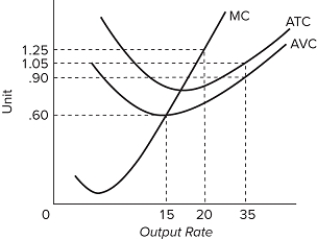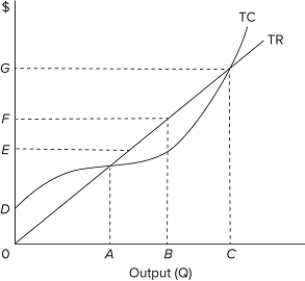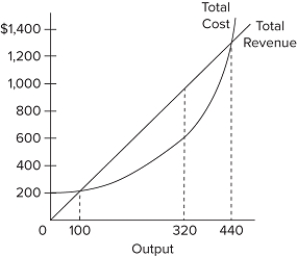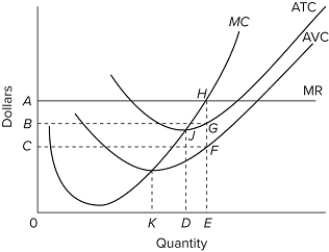A) total revenue and marginal revenue.
B) marginal revenue only.
C) total revenue and average revenue.
D) total revenue only.
Correct Answer

verified
Correct Answer
verified
Multiple Choice
 The accompanying graph shows the cost curves for a competitive firm. If the market price falls to $0.55, the optimal output is
The accompanying graph shows the cost curves for a competitive firm. If the market price falls to $0.55, the optimal output is
A) 0.
B) 15.
C) 20.
D) more than 20, but less than 35.
Correct Answer

verified
Correct Answer
verified
Multiple Choice
The demand schedule or curve confronted by the individual, purely competitive firm is
A) relatively elastic, that is, the elasticity coefficient is greater than unity.
B) perfectly elastic.
C) relatively inelastic, that is, the elasticity coefficient is less than unity.
D) perfectly inelastic.
Correct Answer

verified
Correct Answer
verified
Multiple Choice
 In the graph, the amount of profit is measured by the gap between
In the graph, the amount of profit is measured by the gap between
A) e and the vertical axis.
B) e and the horizontal axis.
C) d and e.
D) e and f.
Correct Answer

verified
Correct Answer
verified
Multiple Choice
Which of the following is not a necessary characteristic of a purely competitive industry?
A) The industry or market demand is highly elastic.
B) Firms can easily enter or leave the industry.
C) There are so many small firms that no one firm can influence the market price.
D) Consumers see no difference between the product of one firm and that of another.
Correct Answer

verified
Correct Answer
verified
Multiple Choice
Given the accompanying table, what is the short-run profit-maximizing level of output for the firm? 
A) 4.
B) 5.
C) 3.
D) 2.
Correct Answer

verified
Correct Answer
verified
Multiple Choice
 The accompanying table shows cost data for a firm that is selling in a purely competitive market. If the price of the product is $3, what output level will the firm produce?
The accompanying table shows cost data for a firm that is selling in a purely competitive market. If the price of the product is $3, what output level will the firm produce?
A) 12
B) 14
C) 0
D) 16
Correct Answer

verified
Correct Answer
verified
Multiple Choice
Suppose that at 500 units of output, marginal revenue is equal to marginal cost. The firm is selling its output at $5 per unit, and average total cost at 500 units of output is $6. On the basis of this information, we
A) can say that the firm should close down in the short run.
B) can say that the firm can produce and realize an economic profit in the short run.
C) cannot determine whether the firm should produce or shut down in the short run.
D) can assume the firm is not using the most efficient technology.
Correct Answer

verified
Correct Answer
verified
Multiple Choice
In a graph for a firm in pure competition with the quantity of output measured on the horizontal axis, the total revenue curve is
A) downward-sloping.
B) horizontal.
C) vertical.
D) upward-sloping.
Correct Answer

verified
Correct Answer
verified
Multiple Choice
Which idea is inconsistent with pure competition?
A) price-taking behavior
B) product differentiation
C) freedom of entry or exit for firms
D) a large number of buyers and sellers
Correct Answer

verified
Correct Answer
verified
True/False
In the short run, fixed costs are important in determining a competitive firm's optimal level of output.
Correct Answer

verified
Correct Answer
verified
Multiple Choice
Suppose that Joe sells pork in a purely competitive market. The market price of pork is $3 per pound. Joe's marginal revenue from selling the 12th pound of pork would be
A) $3.
B) $36.
C) 12 lbs.
D) $12.
Correct Answer

verified
Correct Answer
verified
Multiple Choice
 Refer to the diagram. Other things equal, an increase of product price would be shown as
Refer to the diagram. Other things equal, an increase of product price would be shown as
A) an increase in the steepness of curve (3) , an upward shift in curve (2) , and an upward shift in curve (1) .
B) a decrease in the steepness of curve (3) , a downward shift in curve (2) , and an upward shift in curve (1) .
C) a downward shift in curve (4) and an upward shift in curve (1) , with no changes in curves (2) and (3) .
D) an upward shift in curve (2) only.
Correct Answer

verified
Correct Answer
verified
Multiple Choice
 Refer to the provided graph for a purely competitive firm in the short run. Profits would be maximized if the firm produces which level of output?
Refer to the provided graph for a purely competitive firm in the short run. Profits would be maximized if the firm produces which level of output?
A) A
B) B
C) C
D) greater than C
Correct Answer

verified
Correct Answer
verified
Multiple Choice
 Refer to the short-run data in the accompanying graph. Which of the following is correct?
Refer to the short-run data in the accompanying graph. Which of the following is correct?
A) This firm will maximize its profit at 440 units of output.
B) Any level of output between 100 and 440 units will yield an economic profit.
C) This firm's marginal revenue rises with output.
D) Any level of output less than 100 units or greater than 440 units is profitable.
Correct Answer

verified
Correct Answer
verified
Multiple Choice
The fast-food restaurant industry in a large city would be an example of which market model?
A) monopolistic competition
B) pure competition
C) pure monopoly
D) oligopoly
Correct Answer

verified
Correct Answer
verified
Multiple Choice
Which of the following statements is correct?
A) The demand curve for a purely competitive firm is perfectly elastic, but the demand curve for a purely competitive industry is downsloping.
B) The demand curve for a purely competitive firm is downsloping, but the demand curve for a purely competitive industry is perfectly elastic.
C) The demand curves are downsloping for both a purely competitive firm and a purely competitive industry.
D) The demand curves are perfectly elastic for both a purely competitive firm and a purely competitive industry.
Correct Answer

verified
Correct Answer
verified
Multiple Choice
In answering the question, assume a graph in which dollars are measured on the vertical axis and output on the horizontal axis.For a purely competitive firm, marginal revenue graphs as a
A) straight, upsloping line.
B) straight line, parallel to the vertical axis.
C) straight line, parallel to the horizontal axis.
D) straight, downsloping line.
Correct Answer

verified
Correct Answer
verified
Multiple Choice
In a purely competitive industry, each firm
A) determines its own price.
B) produces a differentiated product.
C) can easily enter or exit the industry.
D) engages in various forms of nonprice competition.
Correct Answer

verified
Correct Answer
verified
Multiple Choice
 According to the accompanying diagram, at the profit-maximizing output, total fixed cost is equal to
According to the accompanying diagram, at the profit-maximizing output, total fixed cost is equal to
A) 0 AHE.
B) 0 BGE.
C) 0 CFE.
D) BCFG.
Correct Answer

verified
Correct Answer
verified
Showing 321 - 340 of 342
Related Exams